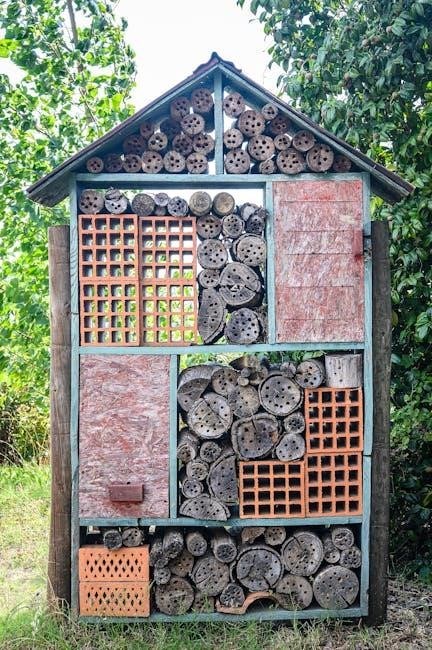
Welcome to the world of Lincoln Logs! This guide provides a comprehensive PDF resource for building iconic structures, offering step-by-step instructions and inspiring creativity for all skill levels.
Overview of Lincoln Logs
Lincoln Logs are iconic wooden building sets that inspire creativity and imagination. Invented by John Lloyd Wright, they consist of interlocking logs and accessories, allowing users to construct various structures. The sets are made from durable materials, ensuring long-lasting play. The PDF instructions provide clear, step-by-step guides for building specific models, while encouraging users to explore their own designs. Perfect for both beginners and experienced builders, Lincoln Logs foster problem-solving skills and creativity. They are a timeless toy, cherished for generations, and remain a popular choice for imaginative play and learning.
Importance of Instructions
The instructions for Lincoln Logs are essential for unlocking their full potential. They provide clear, step-by-step guidance for constructing specific models, ensuring stability and accuracy. The PDF guide helps users understand how to properly connect logs and accessories, making the building process enjoyable and rewarding. Instructions also cater to both children and adults, offering tips for beginners and advanced builders alike. By following the guide, users can avoid common mistakes and bring their creative visions to life. The instructions are a vital tool for maximizing the fun and educational value of Lincoln Logs.

History of Lincoln Logs
Lincoln Logs were invented in 1916 by John Lloyd Wright, son of Frank Lloyd Wright, inspired by interlocking wooden systems. Named after Abraham Lincoln, they reflect pioneer-era building traditions.
Inventor and Background
Lincoln Logs were invented in 1916 by John Lloyd Wright, son of the renowned architect Frank Lloyd Wright. Inspired by his father’s use of interlocking wooden systems, Wright created the iconic toy to foster creativity in children; The name “Lincoln Logs” honors Abraham Lincoln, evoking the log cabins of 19th-century America. This timeless building set has remained a beloved tool for imaginative play, encouraging architectural exploration and problem-solving skills across generations.
Evolution Over Time
Since their invention in 1916 by John Lloyd Wright, Lincoln Logs have evolved significantly. Early sets featured wooden logs, while modern versions incorporate durable plastics and themed designs. The introduction of accessories like windows and doors added detail, while themed sets, such as frontier forts and modern buildings, expanded creative possibilities. In the 1990s, Lincoln Logs became part of Hasbro’s portfolio, ensuring global reach. The 2010s saw the addition of digital resources, including 3D scans and online communities, blending tradition with modern innovation. This evolution has maintained the timeless appeal of Lincoln Logs.
Understanding the PDF Instructions
The Lincoln Logs PDF guide offers clear, step-by-step instructions with detailed diagrams, making it easy for builders of all skill levels to create iconic structures and explore creative possibilities.
Downloading the PDF
Downloading the Lincoln Logs instructions PDF is straightforward. Visit the official manufacturer’s website or trusted resources like Knex or Playskool. Search for your specific set, such as the 100th Anniversary Edition, and locate the download section. Ensure the PDF is from a reputable source to avoid errors. The guide is typically free and provides detailed, step-by-step instructions with visuals. Once downloaded, you can access it on any device, making it easy to follow along while building. Always verify the PDF’s compatibility with your set for accurate construction.
Navigating the Document
The Lincoln Logs instructions PDF is designed for easy navigation, ensuring a seamless building experience. The document typically begins with a parts list, followed by step-by-step assembly instructions. Detailed diagrams and visuals guide users through each stage, from basic constructions to complex designs. Tips for sorting and organizing pieces are often included to enhance efficiency. Troubleshooting sections address common issues like misaligned logs or missing parts. The guide encourages creativity, offering inspiration for custom designs beyond the provided models. Clear headings and indexing make it simple to find specific instructions quickly, catering to both novices and experienced builders.
Key Features of the Guide
The Lincoln Logs instructions PDF stands out with its clear, step-by-step guidance and detailed diagrams. It includes a comprehensive parts list to help builders identify components. The guide offers a variety of project options, from classic cabins to modern designs, catering to different skill levels. Troubleshooting tips and creative freedom encouragement make it versatile. High-quality visuals ensure clarity, while organized content enhances ease of use. Perfect for both beginners and experienced builders, the guide is a valuable resource for unlocking the full potential of Lincoln Logs sets.

Components of Lincoln Logs Sets
Lincoln Logs sets feature high-quality, durable components made from real wood, ensuring long-lasting structures. The sets include various logs, plastic accessories, and detailed instructions for diverse builds.
Types of Logs and Pieces
Lincoln Logs sets include a variety of wooden pieces, such as logs of different lengths, notched logs for corners, and plastic accessories like windows, doors, and roofs. These components are designed to interlock easily, allowing for sturdy and creative constructions. The logs are made from high-quality wood, ensuring durability and a classic aesthetic. Accessories add functional and decorative elements, enhancing the overall building experience. Each piece is crafted to fit seamlessly together, enabling users to bring their imaginative designs to life with precision and ease.
Accessories Included
Lincoln Logs sets come with a range of plastic accessories to enhance your creations, including windows, doors, and roofs. These pieces add functional and decorative details, allowing for more intricate designs. Some sets also include figurines or additional decorative elements to bring structures to life. The accessories are designed to fit seamlessly with the wooden logs, ensuring a polished and professional finish. They complement the natural beauty of the logs while offering endless possibilities for customization and creativity in your building projects.
Quality and Durability
Lincoln Logs are crafted from high-quality, real wood, ensuring lasting durability and a classic aesthetic. The logs are precision-cut for a snug fit, making construction stable and secure. Plastic accessories, such as windows and doors, add vibrant colors and functional details without compromising durability. Designed to withstand years of play, these sets are built to endure, offering both creative fun and long-lasting value. The combination of natural wood and durable plastics ensures that Lincoln Logs remain a timeless and reliable choice for builders of all ages.

Building Techniques
Master Lincoln Logs construction with basic stacking methods, interlocking notches, and creative layouts. Ensure stability by aligning logs securely, then experiment with intricate designs for endless possibilities.
Basic Construction Methods
Lincoln Logs are designed with interlocking notches that allow pieces to fit securely together. Start by laying a single log as the foundation, ensuring it is flat and stable. Build upward by stacking logs, aligning notches carefully to maintain balance. Use the provided diagrams in the PDF guide for visual guidance. These methods are ideal for both children and adults, promoting creativity while ensuring structural integrity. Begin with simple designs, like a cabin, before advancing to more complex creations. Experiment with different orientations to explore various architectural possibilities and master the fundamentals of Lincoln Logs building.
Advanced Tips and Tricks
For advanced builders, experiment with intricate designs by alternating log orientations for added stability. Use plastic accessories to enhance details without compromising structure. To achieve symmetry, plan your design beforehand or mirror builds on either side. Incorporate varied roof styles for visual appeal and explore layered constructions for depth. For taller structures, focus on a wide base and gradual tapering to prevent wobbling. Mix and match pieces from different sets for unique creations. These techniques unlock endless possibilities, encouraging mastery and creative expression in every Lincoln Logs project.
Encouraging Creative Freedom
Lincoln Logs instructions empower builders to explore their creativity, offering guidance while inspiring imaginative designs. The PDF guide provides foundational techniques, allowing users to venture beyond predefined models and craft unique structures. With real wood logs and colorful plastic accessories, the possibilities are endless. Encourage experimentation with shapes, themes, and storytelling through your builds. Whether recreating historical designs or inventing futuristic creations, Lincoln Logs foster a sense of freedom and self-expression, making every project a personalized masterpiece.

Popular Projects and Designs
Explore classic cabins, forts, and frontier structures, or create modern designs like banks and barns. The PDF guide offers blueprint layouts for iconic builds, sparking creativity and precision.
Classic Cabins and Forts
Classic cabins and forts are timeless projects that embody the spirit of Lincoln Logs. These designs, inspired by pioneer-era structures, allow builders to recreate historical landmarks or imaginative frontier setups. The PDF guide provides detailed blueprints for constructing iconic cabins with intricate details like chimneys and doors. Forts, with their interlocking walls and towers, offer endless possibilities for creative defense systems. Made from real wood, these structures are durable and visually authentic. Step-by-step instructions ensure even beginners can assemble these classic designs, fostering a sense of history and craftsmanship while encouraging imaginative play.
Modern and Custom Designs
Modern and custom designs expand the creative possibilities of Lincoln Logs, allowing builders to go beyond traditional cabins and forts. The PDF guide offers inspiration for contemporary structures, blending classic interlocking log techniques with innovative ideas. Builders can craft unique designs, from sleek modern homes to intricate cityscapes, using the versatile wooden pieces. Digital tools and 3D models further enhance customization, enabling users to visualize and create complex designs. Whether following detailed plans or experimenting freely, modern designs showcase the timeless adaptability of Lincoln Logs in today’s creative landscape.
Community and User-Created Plans
The Lincoln Logs community thrives on creativity, with users sharing custom designs and plans online. Enthusiasts worldwide upload their unique creations, from intricate forts to modern houses, inspiring others to experiment. These user-generated plans often include detailed step-by-step instructions and photos, making it easy for builders of all skill levels to recreate or adapt the designs. Online forums and social media groups dedicated to Lincoln Logs foster collaboration, allowing fans to exchange ideas and showcase their projects. This shared creativity has become a cornerstone of the Lincoln Logs legacy, encouraging endless innovation and engagement among builders.

Troubleshooting Common Issues
Identify common problems like logs not fitting or missing pieces. Align logs properly and check for damage. Reorganize your set for easier access and future builds.
Logs Not Fitting Properly
If logs are not fitting, check for dirt or debris. Clean the notches and ends with a soft cloth. Ensure logs are dry, as moisture can cause warping.
Align the notches carefully, as improper alignment can prevent a secure fit. If logs still don’t connect, inspect for splinters or damage. Lightly sand rough edges.
For stubborn pieces, gently tap them into place. Avoid forcing, as this may cause breakage. Proper care and alignment ensure a sturdy and seamless structure.
Missing or Damaged Pieces
If pieces are missing or damaged, first verify the inventory list. Contact the manufacturer or customer support for replacements. For damaged pieces, gently sand rough edges to smooth them. Avoid using force, as it may worsen the damage. If a piece is unusable, consider substituting with a similar part from another set. Proper care and storage can prevent future damage. Always refer to the PDF instructions for guidance on handling and maintaining your Lincoln Logs collection effectively.
Reorganizing the Set
Reorganizing your Lincoln Logs set enhances building efficiency and creativity. Begin by categorizing pieces by type and size, storing them in labeled bins or cases. Use the original packaging or opt for storage solutions that protect the pieces. Regularly check for missing or damaged items and replace them as needed. This systematic approach ensures all components are easily accessible, allowing you to focus on construction without interruptions; A well-organized set also helps maintain the quality of your collection and inspires future building projects. Refer to the PDF guide for tips on organizing your Lincoln Logs effectively.
Safety Precautions
Use Lincoln Logs on clean, hard surfaces to avoid staining and damage. Handle with care to prevent splintering. Keep small pieces out of reach of young children for choking hazards. Regularly inspect logs for damage and store them properly to maintain quality and ensure safe play. Always follow the PDF guide’s recommendations for safe building practices.
Recommended Surfaces
For optimal building experiences, use Lincoln Logs on clean, flat, and stable surfaces like tables or floors. Avoid carpets and absorbent materials to prevent staining. Hardwood or plastic playmats are ideal for protecting logs and surfaces. Ensure the area is clear of debris to allow smooth assembly. Avoid damp or uneven surfaces to maintain log stability. Follow the PDF guide’s surface recommendations to preserve log quality and ensure a secure building foundation. Proper surface selection enhances both play and durability, making it essential for enjoyable and long-lasting construction sessions.
Avoiding Damage
To prevent damage to your Lincoln Logs, handle them with care. Avoid forcing pieces together, as this can cause warping or splitting. Keep the logs clean and dry, as moisture may harm the wood. Store them in a cool, dry place away from direct sunlight to preserve their finish. Regularly inspect for splinters or wear and gently sand rough edges. Use a soft cloth to wipe away dust and avoid harsh chemicals. Proper care ensures your set remains in excellent condition for years of creative building and play.
Child Safety Guidelines
Ensure child safety while playing with Lincoln Logs by supervising young children during construction. Small pieces can pose a choking hazard, so recommend the set for children aged 3 and above. Teach kids to handle the logs gently to avoid splinters or injuries. Keep the play area clean and free from tiny accessories. Encourage children to build on smooth, flat surfaces to prevent accidental damage. Always prioritize safety to ensure an enjoyable and educational building experience for your child.

Digital Resources and Tools
Explore 3D scans, online communities, and design software to enhance your Lincoln Logs experience. These digital tools offer inspiration, tutorials, and innovative ways to create and share designs.
3D Scans and Models
3D scans and models of Lincoln Logs offer a modern twist to traditional building. These digital resources allow enthusiasts to create and print custom pieces, expanding creative possibilities. Museum-quality models can be downloaded for personal use, enabling builders to craft intricate designs with precision. Online platforms like 3Ders.org provide access to these files, fostering innovation and community sharing. This fusion of classic toys with cutting-edge technology inspires builders to explore new frontiers in construction and design, blending nostalgia with futuristic creativity.
Online Communities
Online communities dedicated to Lincoln Logs foster collaboration and creativity among enthusiasts. These forums and groups share tips, showcase projects, and provide support for builders of all levels. Members often exchange custom designs and modifications, inspiring others to explore new ideas. Resources like PDF guides and 3D models are frequently shared, helping users enhance their building skills. These communities serve as a hub for Lincoln Logs fans, promoting innovation and preserving the legacy of this timeless toy. Active participation encourages creative freedom and camaraderie among builders worldwide.
Software for Designing
Software tools like 3D modeling programs allow users to design Lincoln Logs structures digitally before building them physically. These programs provide precise measurements and visualizations, helping creators plan complex designs. Some software even offers libraries of Lincoln Logs pieces for accurate representation. This digital approach enhances creativity and ensures a smooth transition from concept to construction. Additionally, online resources and communities share custom 3D models, inspiring builders to experiment with innovative designs. These tools bridge traditional craftsmanship with modern technology, offering endless possibilities for Lincoln Logs enthusiasts.

Organizing Your Collection
Keep your Lincoln Logs collection tidy by storing pieces in labeled containers. Regularly clean and categorize logs to maintain quality and ensure easy access for future projects.
Storage Solutions
Proper storage is essential for maintaining the quality of your Lincoln Logs collection. Use airtight containers or bins to protect the pieces from dust and moisture. Consider organizing the logs by size and type for easy access. Dividers or small compartments can help keep the set tidy. Store the containers in a cool, dry place to prevent warping or damage. For added convenience, choose containers with handles for portability. Regularly clean and inspect the pieces before storage to ensure longevity. This method also helps prevent losing small accessories, keeping everything in one place for future projects.
Categorizing Pieces
Categorizing your Lincoln Logs pieces is crucial for efficient building and organization. Start by separating the logs by length, as they come in various sizes. Use labeled containers or compartments to store different types, such as roof pieces, doors, and windows. This system ensures easy access when constructing specific designs. Additionally, sort accessories like plastic connectors and chimneys into smaller bins. Maintain this order by cleaning and categorizing after each use. This method prevents losing pieces and saves time during future projects, making your building experience more enjoyable and streamlined. Regularly check for damaged items and replace them to keep your set in great condition.
Maintenance Tips
To keep your Lincoln Logs sets in excellent condition, regular maintenance is essential. Clean the pieces with a soft cloth and mild soap solution to remove dirt and stains. Avoid exposing the logs to damp environments or extreme temperatures, as this may cause warping. Store the set in a dry, cool place to preserve the wood. Inspect the pieces periodically for damage or wear and tear. Replace any broken parts promptly to ensure optimal performance. Proper care extends the lifespan of your Lincoln Logs, maintaining their quality and functionality for years of creative building. Regular upkeep ensures your collection remains in pristine condition.

Customer Support and FAQs
For inquiries or issues, visit the official Lincoln Logs website for contact details and FAQs. The support team is ready to assist with any questions or concerns.
Contacting the Manufacturer
To reach Lincoln Logs’ customer support, visit their official website for contact details. You can email or call their support team for assistance with instructions or product issues. The manufacturer also provides a dedicated webpage for FAQs and troubleshooting. For specific inquiries about PDF instructions, refer to the “Support” section on their site. Representatives are available Monday through Friday during business hours to address concerns. Ensure to include your product details for faster resolution. The website also offers downloadable resources and user manuals for convenience. Contacting the manufacturer is a reliable way to resolve any questions or issues promptly and effectively.
Frequently Asked Questions
Common questions about Lincoln Logs instructions include where to download the PDF, compatibility with different sets, and troubleshooting missing pieces. The PDF guide covers basic and advanced builds, ensuring clarity for all skill levels. Users often ask about set-specific instructions, which are available on the manufacturer’s website. Questions about damaged or missing pieces are addressed in the troubleshooting section. For additional help, the FAQ section on the official site provides detailed solutions and resources. This ensures a smooth building experience for everyone. The PDF is regularly updated to include new designs and features, making it a reliable resource for builders of all ages.
Warranty and Returns
Lincoln Logs sets are backed by a warranty covering manufacturing defects for one year from purchase. Returns or replacements are available for defective pieces. Contact customer support for assistance. The warranty ensures durability and quality, reflecting the brand’s commitment to excellence. For detailed warranty terms and return procedures, refer to the official website or the PDF instructions provided with your set. This policy helps maintain customer satisfaction and trust in the product’s reliability and performance over time.

Legacy and Cultural Impact
Lincoln Logs have left a lasting legacy as a beloved toy, fostering creativity and problem-solving skills across generations. Their historical significance and educational benefits make them a cherished collectible, preserving their cultural impact for years to come.
Historical Significance
Lincoln Logs hold a special place in toy history, invented by John Lloyd Wright in 1916. Named after Abraham Lincoln, they reflect pioneer-era cabin construction. The original design inspired countless builders, becoming a cultural icon. Over a century, they’ve evolved while maintaining their timeless appeal. Their durability and educational value have made them a staple in many households, preserving their legacy as a tool for creativity and learning. Today, they remain a testament to innovative design and historical craftsmanship.
Educational Benefits
Lincoln Logs foster creativity, problem-solving, and critical thinking in children. They enhance fine motor skills and hand-eye coordination through hands-on building. The structured instructions in the PDF guide teach sequencing and planning, essential for understanding basic engineering and architecture. These skills not only improve dexterity but also encourage analytical thinking. By following and interpreting the guides, children develop patience and attention to detail. The educational value of Lincoln Logs lies in their ability to make learning fun while building a strong foundation for future academic success and a lifelong love for creative building.
Collectibility
Lincoln Logs have become a beloved collectible item for many enthusiasts. Vintage sets, rare designs, and limited editions are highly sought after by collectors. The historical significance and nostalgic appeal of these logs make them valuable treasures. Collectors often seek out original instructions, boxes, and complete sets in pristine condition. The enduring popularity of Lincoln Logs ensures their collectibility, with certain editions gaining significant value over time. For many, these logs represent a connection to childhood memories and the legacy of John Lloyd Wright’s iconic design.

